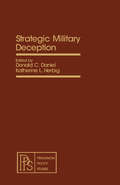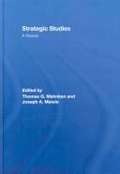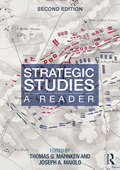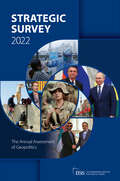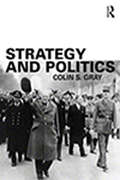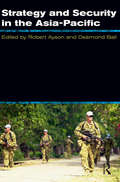- Table View
- List View
Strategic Logic and Political Rationality: Essays in Honor of Michael I. Handel
by Bradford A. Lee Karl F. WallingOne of three volumes in honour of the teaching and scholarship of the late Michael I. Handel, this book details the universal logic of strategy and the ability of liberal-democratic governments to address this logic rationally.Treating war as an extension of politics, the diverse contributors (drawn from the United States, the United Kingdom, Australia and Israel) explore the difficulties in matching strategy to policy, especially in free societies.
Strategic Military Deception: Pergamon Policy Studies on Security Affairs
by Donald C. Daniel Katherine L. HerbigStrategic Military Deception explains the nature of deception, its processes, and the elements and conditions when a person used and succeeds at deception. The main focus of the book is the discussion of strategic military deceptions. The book is mainly a collection of research that seeks to develop a common idea of deception’s basic elements and its relationships. The first part of the book contains such topics as the application of game, communication, organization, and systems theories. The second part of the book deals with the testing and validation of some of the theories of deception through a series of historical case studies. By analyzing a series of cases, the book identifies some recurring patterns in a group of deception cases. There are also chapters that focus on the use of deception during World War II. The book will be a useful tool for military agents, game theorists, and psychoanalysts.
Strategic Narratives, Public Opinion and War: Winning domestic support for the Afghan War (Contemporary Security Studies)
by Beatrice De Graaf George Dimitriu Jens RingsmoseThis volume explores the way governments endeavoured to build and maintain public support for the war in Afghanistan, combining new insights on the effects of strategic narratives with an exhaustive series of case studies. In contemporary wars, with public opinion impacting heavily on outcomes, strategic narratives provide a grid for interpreting the why, what and how of the conflict. This book asks how public support for the deployment of military troops to Afghanistan was garnered, sustained or lost in thirteen contributing nations. Public attitudes in the US, Canada, Australia and Europe towards the use of military force were greatly shaped by the cohesiveness and content of the strategic narratives employed by national policy-makers. Assessing the ability of countries to craft a successful strategic narrative, the book addresses the following key areas: 1) how governments employ strategic narratives to gain public support; 2) how strategic narratives develop during the course of the conflict; 3) how these narratives are disseminated, framed and perceived through various media outlets; 4) how domestic audiences respond to strategic narratives; 5) how this interplay is conditioned by both events on the ground, in Afghanistan, and by structural elements of the domestic political systems. This book will be of much interest to students of international intervention, foreign policy, political communication, international security, strategic studies and IR in general.
Strategic Narratives, Public Opinion and War: Winning domestic support for the Afghan War (Contemporary Security Studies)
by Beatrice De Graaf George Dimitriu Jens RingsmoseThis volume explores the way governments endeavoured to build and maintain public support for the war in Afghanistan, combining new insights on the effects of strategic narratives with an exhaustive series of case studies. In contemporary wars, with public opinion impacting heavily on outcomes, strategic narratives provide a grid for interpreting the why, what and how of the conflict. This book asks how public support for the deployment of military troops to Afghanistan was garnered, sustained or lost in thirteen contributing nations. Public attitudes in the US, Canada, Australia and Europe towards the use of military force were greatly shaped by the cohesiveness and content of the strategic narratives employed by national policy-makers. Assessing the ability of countries to craft a successful strategic narrative, the book addresses the following key areas: 1) how governments employ strategic narratives to gain public support; 2) how strategic narratives develop during the course of the conflict; 3) how these narratives are disseminated, framed and perceived through various media outlets; 4) how domestic audiences respond to strategic narratives; 5) how this interplay is conditioned by both events on the ground, in Afghanistan, and by structural elements of the domestic political systems. This book will be of much interest to students of international intervention, foreign policy, political communication, international security, strategic studies and IR in general.
Strategic Studies: A Reader (PDF)
by Thomas G. Mahnken Joseph A. MaioloThis new Reader brings together key essays on strategic theory by some of the leading contributors in the field. Filling a large gap in the market, it will guide students through both the theoretical and practical aspects of Strategic Studies. Including classic essays and works of contemporary scholarship, the volume provides a wide-ranging survey of the key ideas and themes in the field of Strategic Studies. It comprises six thematic sections, each of which has an Editors Introduction and suggestions for further reading: uses of strategic theory interpretation of the classics instruments of war: land, sea, and air power nuclear strategy irregular warfare and small wars future warfare, future strategy Striking a balance between theoretical essays and case studies, the Strategic Studies Reader will be essential reading for all students of strategic studies, international security and modern warfare, as well as for professional military students. "
Strategic Studies: A Reader (Studies In Strategic And Military History Ser.)
by Thomas G. Mahnken Joseph A. MaioloThe second edition of Strategic Studies: A Reader brings together key essays on strategic theory by some of the leading contributors to the field. This revised volume contains several new essays and updated introductions to each section. The volume comprises hard-to-find classics in the field as well as the latest scholarship. The aim is to provide students with a wide-ranging survey of the key issues in strategic studies, and to provide an introduction to the main ideas and themes in the field. The book contains six extensive sections, each of which is prefaced by a short introductory essay: The Uses of Strategic Theory Interpretation of the Classics Instruments of War, Intelligence and Deception Nuclear Strategy Irregular Warfare and Small Wars Future Warfare, Future Strategy Overall, this volume strikes a balance between theoretical works, which seek to discover generalisations about the nature of modern strategy, and case studies, which attempt to ground the study of strategy in the realities of modern war. This new edition will be essential reading for all students of strategic studies, security studies, military history and war studies, as well as for professional military college students.
Strategic Studies: A Reader
by Thomas G. Mahnken Joseph A. MaioloThe second edition of Strategic Studies: A Reader brings together key essays on strategic theory by some of the leading contributors to the field. This revised volume contains several new essays and updated introductions to each section. The volume comprises hard-to-find classics in the field as well as the latest scholarship. The aim is to provide students with a wide-ranging survey of the key issues in strategic studies, and to provide an introduction to the main ideas and themes in the field. The book contains six extensive sections, each of which is prefaced by a short introductory essay: The Uses of Strategic Theory Interpretation of the Classics Instruments of War, Intelligence and Deception Nuclear Strategy Irregular Warfare and Small Wars Future Warfare, Future Strategy Overall, this volume strikes a balance between theoretical works, which seek to discover generalisations about the nature of modern strategy, and case studies, which attempt to ground the study of strategy in the realities of modern war. This new edition will be essential reading for all students of strategic studies, security studies, military history and war studies, as well as for professional military college students.
The Strategic Survey 2021 (Strategic Survey)
by The International Institute for Strategic StudiesStrategic Survey 2021: The Annual Assessment of Geopolitics provides objective, in-depth analysis by leading experts of the events, actors and forces driving international relations. It is the indispensable guide for policymakers, business leaders, analysts and academics who need to understand the geopolitical and geo-economic trends shaping the global agenda in 2022 and beyond. Key features · Comprehensive annual review of world affairs from the International Institute for Strategic Studies, the leading international research institute that provides objective analysis of military, geopolitical and geo-economic developments that could lead to conflict. · Covers developments in all regions as well as emerging issues and trends not yet on most radars, and analyses the major themes and forces shaping each continent. · Essays on a comprehensive range of global issues including vaccine diplomacy, digital conflict, Europe’s emerging Asia-Pacific strategies, the rise of carbon neutrality, the prospects for Iran’s nuclear programme, and the future of political Islam. · Drivers of Strategic Change for major states: Verified, comparable data on state power that provides a rich and vivid guide to forces underlying geopolitical change. · Data-rich graphics and maps that provide fresh insights into geopolitical change, and a timeline of the key events of 2020–21.
The Strategic Survey 2021 (Strategic Survey)
by The International The International Institute for Strategic Studies (IISS)Strategic Survey 2021: The Annual Assessment of Geopolitics provides objective, in-depth analysis by leading experts of the events, actors and forces driving international relations. It is the indispensable guide for policymakers, business leaders, analysts and academics who need to understand the geopolitical and geo-economic trends shaping the global agenda in 2022 and beyond. Key features · Comprehensive annual review of world affairs from the International Institute for Strategic Studies, the leading international research institute that provides objective analysis of military, geopolitical and geo-economic developments that could lead to conflict. · Covers developments in all regions as well as emerging issues and trends not yet on most radars, and analyses the major themes and forces shaping each continent. · Essays on a comprehensive range of global issues including vaccine diplomacy, digital conflict, Europe’s emerging Asia-Pacific strategies, the rise of carbon neutrality, the prospects for Iran’s nuclear programme, and the future of political Islam. · Drivers of Strategic Change for major states: Verified, comparable data on state power that provides a rich and vivid guide to forces underlying geopolitical change. · Data-rich graphics and maps that provide fresh insights into geopolitical change, and a timeline of the key events of 2020–21.
The Strategic Survey 2022
by The International Institute for Strategic StudiesStrategic Survey 2022: The Annual Assessment of Geopolitics provides objective, in-depth analysis of the events that have shaped relations between major powers, region by region, over the past year, and highlights the pressing geopolitical and geo-economic challenges that will shape the international agenda in 2023. It features essays on global issues such as Russia’s war in Ukraine, the arms race in space and the deepening US–China rivalry, as well as in-depth analysis of the major themes shaping each continent. Specially commissioned maps and graphics illustrate major arguments, and multi-source data illuminates longer-term trends in power relations.
The Strategic Survey 2022
Strategic Survey 2022: The Annual Assessment of Geopolitics provides objective, in-depth analysis of the events that have shaped relations between major powers, region by region, over the past year, and highlights the pressing geopolitical and geo-economic challenges that will shape the international agenda in 2023. It features essays on global issues such as Russia’s war in Ukraine, the arms race in space and the deepening US–China rivalry, as well as in-depth analysis of the major themes shaping each continent. Specially commissioned maps and graphics illustrate major arguments, and multi-source data illuminates longer-term trends in power relations.
Strategic Terror: The Politics and Ethics of Aerial Bombardment
by Beau GrosscupPresenting a global history of aerial bombardment, this book shows how certain European powers initiated aerial bombardment of civilians after World War I, and how it was an instrument of choice in World War II. Beau Grosscup shows that such methods, used initially as a means of terrorizing native populations in Africa and the Middle East, have become the primary form of terrorism in more recent decades.While such 'strategic terror' is not classed as 'terrorism' in the West, this reflects an unwillingness to confront the human costs and immorality of aerial bombardment. Grosscup argues that if terrorism is to be diminished, the role of aerial bombing in sustaining global violence must be recognized.
Strategic Terror: The Politics and Ethics of Aerial Bombardment
by Beau GrosscupPresenting a global history of aerial bombardment, this book shows how certain European powers initiated aerial bombardment of civilians after World War I, and how it was an instrument of choice in World War II. Beau Grosscup shows that such methods, used initially as a means of terrorizing native populations in Africa and the Middle East, have become the primary form of terrorism in more recent decades.While such 'strategic terror' is not classed as 'terrorism' in the West, this reflects an unwillingness to confront the human costs and immorality of aerial bombardment. Grosscup argues that if terrorism is to be diminished, the role of aerial bombing in sustaining global violence must be recognized.
The Strategists: Churchill, Stalin, Roosevelt, Mussolini and Hitler – How War Made Them, And How They Made War
by Phillips Payson O'Brien'Entirely fresh, brilliantly insightful and utterly compelling' James Holland'Full of fascinating insights about the use and misuse of power' Daniel Todman***Churchill. Hitler. Stalin. Mussolini. Roosevelt. Five of the most impactful leaders of WW2, each with their own individualistic and idiosyncratic approach to warfare. But if we want to understand their military strategy, we must first understand the strategist.In THE STRATEGISTS, Professor Phillips Payson O'Brien shows how the views these five leaders forged in WW1 are crucial to understanding how they fought WW2. For example, Churchill's experiences of facing the German Army in France in 1916 made him unwilling to send masses of British soldiers back there in the 1940s, while Hitler's mistakes on the Eastern Front were influenced by his reluctance to accept that conditions had changed since his own time fighting. The implications of the power of leaders remain with us to this day: to truly understand what is happening in Ukraine, for example, requires us to know what has influenced the leaders involved.This is a history in which leaders – and their choices – matter. For better or worse.***'For military history buffs, this is a must-read.' Publishers Weekly
Strategy: Key Thinkers (Key Thinkers)
by Tom KaneOver twenty two centuries ago, the Greek general Pyrrhus questioned the real gains of military victory. Today we might reflect on the recent wars in Iraq and Afghanistan in much the same way. War is not only cruel but capricious; its outcomes are often bitter and frustrating, even for the winning side. Strategy: Key Thinkers expertly introduces the ideas of major strategic thinkers whose work explores the complex challenges associated with the use of military force. Early chapters deal with the foundational work of Sun Tzu (Sunzi), Thucydides, Vegetius, Machiavelli and Carl von Clausewitz and their relevance to problems facing Western militaries today. The book then considers broader issues, such as the distinctive importance of air and maritime operations, the difficulty of waging offensive land warfare in the face of modern firepower, the implications of nuclear weapons, and the potential of irregular warfare. It concludes by highlighting key themes which connect - and distinguish - the works under consideration, noting how these similarities and differences can inform the strategic debates of the early twenty-first century.
Strategy: Key Thinkers (Key Thinkers)
by Tom KaneOver twenty two centuries ago, the Greek general Pyrrhus questioned the real gains of military victory. Today we might reflect on the recent wars in Iraq and Afghanistan in much the same way. War is not only cruel but capricious; its outcomes are often bitter and frustrating, even for the winning side. Strategy: Key Thinkers expertly introduces the ideas of major strategic thinkers whose work explores the complex challenges associated with the use of military force. Early chapters deal with the foundational work of Sun Tzu (Sunzi), Thucydides, Vegetius, Machiavelli and Carl von Clausewitz and their relevance to problems facing Western militaries today. The book then considers broader issues, such as the distinctive importance of air and maritime operations, the difficulty of waging offensive land warfare in the face of modern firepower, the implications of nuclear weapons, and the potential of irregular warfare. It concludes by highlighting key themes which connect - and distinguish - the works under consideration, noting how these similarities and differences can inform the strategic debates of the early twenty-first century.
Strategy: The Logic of War and Peace, Revised and Enlarged Edition
by Edward N. Luttwak“If you want peace, prepare for war.” “A buildup of offensive weapons can be purely defensive.” “The worst road may be the best route to battle.” Strategy is made of such seemingly self-contradictory propositions, Edward Luttwak shows—they exemplify the paradoxical logic that pervades the entire realm of conflict. In this widely acclaimed work, now revised and expanded, Luttwak unveils the peculiar logic of strategy level by level, from grand strategy down to combat tactics. Having participated in its planning, Luttwak examines the role of air power in the 1991 Gulf War, then detects the emergence of “post-heroic” war in Kosovo in 1999—an American war in which not a single American soldier was killed. In the tradition of Carl von Clausewitz, Strategy goes beyond paradox to expose the dynamics of reversal at work in the crucible of conflict. As victory is turned into defeat by over-extension, as war brings peace by exhaustion, ordinary linear logic is overthrown. Citing examples from ancient Rome to our own days, from Barbarossa and Pearl Harbor down to minor combat affrays, from the strategy of peace to the latest operational methods of war, this book by one of the world’s foremost authorities reveals the ultimate logic of military failure and success, of war and peace.
Strategy And Defence Planning: Meeting The Challenge Of Uncertainty
by Colin S. GrayStrategy and Defence Planning: Meeting the Challenge of Uncertainty explores and examines why and how security communities prepare purposefully for their future defence. The author explains that defence planning is the product of interplay among political process, historical experience, and the logic of strategy. The theory of strategy best reveals both the nature and the working of defence planning. Political 'ends', strategic 'ways', and military 'means' all fed by reigning, if not always recognized, assumptions, organize the subject well with a template that can serve any time, place, and circumstance. The book is designed to help understanding of what can appear to be a forbiddingly complex as well as technical subject. A good part of the problem for officials charged with defence planning duties is expressed in the second part of the book's title. The real difficulty, which rarely is admitted by those tasked with defence planning duty, is that defence planning can only be guesswork. But, because defence preparation is always expensive, not untypically is politically unpopular, yet obviously can be supremely important, claims to knowledge about the truly unknowable persist. In truth, we cannot do defence planning competently, because our ignorance of the future precludes understanding of what our society will be shown by future events to need. The challenge faced by the author was to identify ways in which our problems with the inability to know the future in any detail in advance-the laws of nature, in other words-may best be met and mitigated. Professor Gray argues that our understanding of human nature, of politics, and of strategic history, does allow us to make prudent choices in defence planning that hopefully will prove 'good enough'.
Strategy and History: Essays on Theory and Practice (Strategy and History)
by Colin S. GrayStrategy and History comprises a selection of Professor Gray's key contributions to strategic debate over the past thirty years. These essays have been selected both because they had significant messages for contemporary controversies, and because they have some continuing relevance for today and the future. Each essay in this book is really about strategy in the modern world, and reflects the many dimensions of this complex subject. This book covers a wide range of subjects and historical events, but there are key issues covered throughout: being strategic the consequences of actions a respect for Clausewitz’s theory of war historical dependency the importance of geography being critical of enthusiasm for technology over human factors the primacy of politics. This important publication provides an invaluable insight into the development of strategic studies over the past 30 years from one of the world's leading theorists and practitioners of the subject. The book will be of great interest to all students and analysts of strategy and international studies.
Strategy and History: Essays on Theory and Practice (Strategy and History)
by Colin S. GrayStrategy and History comprises a selection of Professor Gray's key contributions to strategic debate over the past thirty years. These essays have been selected both because they had significant messages for contemporary controversies, and because they have some continuing relevance for today and the future. Each essay in this book is really about strategy in the modern world, and reflects the many dimensions of this complex subject. This book covers a wide range of subjects and historical events, but there are key issues covered throughout: being strategic the consequences of actions a respect for Clausewitz’s theory of war historical dependency the importance of geography being critical of enthusiasm for technology over human factors the primacy of politics. This important publication provides an invaluable insight into the development of strategic studies over the past 30 years from one of the world's leading theorists and practitioners of the subject. The book will be of great interest to all students and analysts of strategy and international studies.
Strategy and Nuclear Deterrence
by Steven E. MillerThis book of selections from the distinguished journal International Security speaks to the most important question of our age: the deterrence of nuclear war.Originally published in 1985.The Princeton Legacy Library uses the latest print-on-demand technology to again make available previously out-of-print books from the distinguished backlist of Princeton University Press. These editions preserve the original texts of these important books while presenting them in durable paperback and hardcover editions. The goal of the Princeton Legacy Library is to vastly increase access to the rich scholarly heritage found in the thousands of books published by Princeton University Press since its founding in 1905.
Strategy and Politics
by Colin S. GrayThis book examines the subject of strategy and its relationship with politics. Despite the fact that strategy is always the product of political process, the relationship between the two concepts and their ancillary activities has scarcely been touched by scholars. This book corrects that serious deficiency, and explains the high relevance of political factors for matters of general defence. Each chapter aims to show how and why strategy and politics interact and how this interaction has had significant consequences historically. Neither strategy nor politics can make sense if considered alone. Strategy requires direction that can only be provided by political process, while politics cannot be implemented without strategy. In summary, this volume will explain: what strategy is (and is not) why strategy is essential what strategy does and how it does it how strategy is made and executed Written by a leading scholar and former practitioner, this book will be essential reading for all students of military strategy, strategic studies, security studies and war and conflict studies.
Strategy and Politics
by Colin S. GrayThis book examines the subject of strategy and its relationship with politics. Despite the fact that strategy is always the product of political process, the relationship between the two concepts and their ancillary activities has scarcely been touched by scholars. This book corrects that serious deficiency, and explains the high relevance of political factors for matters of general defence. Each chapter aims to show how and why strategy and politics interact and how this interaction has had significant consequences historically. Neither strategy nor politics can make sense if considered alone. Strategy requires direction that can only be provided by political process, while politics cannot be implemented without strategy. In summary, this volume will explain: what strategy is (and is not) why strategy is essential what strategy does and how it does it how strategy is made and executed Written by a leading scholar and former practitioner, this book will be essential reading for all students of military strategy, strategic studies, security studies and war and conflict studies.
Strategy and Security in the Asia-Pacific: Global and regional dynamics (Canberra Papers On Strategy And Defence #No. 139)
by Robert Ayson Desmond BallFrom the war on terror to the rise of China, this book unlocks the major strategic themes and security challenges of the early twenty-first century. Strategy and Security in the Asia-Pacific provides the analytical frameworks needed to make sense of this complex but exciting strategic universe. Offering a unique mix of global strategic thinking and Asia-Pacific security analysis, this book is for readers from Sydney to Seoul who want to put their own local security challenges in a wider regional and global context. It is also for North American and European readers requiring an understanding of the dynamic security developments in the Asia-Pacific region around which so much of global strategy is increasingly based. The really vital questions facing the international community are dealt with here: Why do governments and groups still use armed force? Has warfare really changed in the information age? Why should we be concerned about non-traditional security challenges such as water shortages and the spread of infectious disease? Is a great clash imminent between the United States and China? What are the prospects for peace on the Korean peninsula and between India and Pakistan? Can Southeast Asia survive the challenges of transnational terrorism? What does security mean for the Pacific island countries and for Australia and New Zealand? With contributions from leading commentators and analysts, Strategy and Security in the Asia-Pacific offers a comprehensive and authoritative introduction to the field.
Strategy and Security in the Asia-Pacific: Global and regional dynamics
by Desmond Ball Robert AysonFrom the war on terror to the rise of China, this book unlocks the major strategic themes and security challenges of the early twenty-first century. Strategy and Security in the Asia-Pacific provides the analytical frameworks needed to make sense of this complex but exciting strategic universe. Offering a unique mix of global strategic thinking and Asia-Pacific security analysis, this book is for readers from Sydney to Seoul who want to put their own local security challenges in a wider regional and global context. It is also for North American and European readers requiring an understanding of the dynamic security developments in the Asia-Pacific region around which so much of global strategy is increasingly based. The really vital questions facing the international community are dealt with here: Why do governments and groups still use armed force? Has warfare really changed in the information age? Why should we be concerned about non-traditional security challenges such as water shortages and the spread of infectious disease? Is a great clash imminent between the United States and China? What are the prospects for peace on the Korean peninsula and between India and Pakistan? Can Southeast Asia survive the challenges of transnational terrorism? What does security mean for the Pacific island countries and for Australia and New Zealand? With contributions from leading commentators and analysts, Strategy and Security in the Asia-Pacific offers a comprehensive and authoritative introduction to the field.

